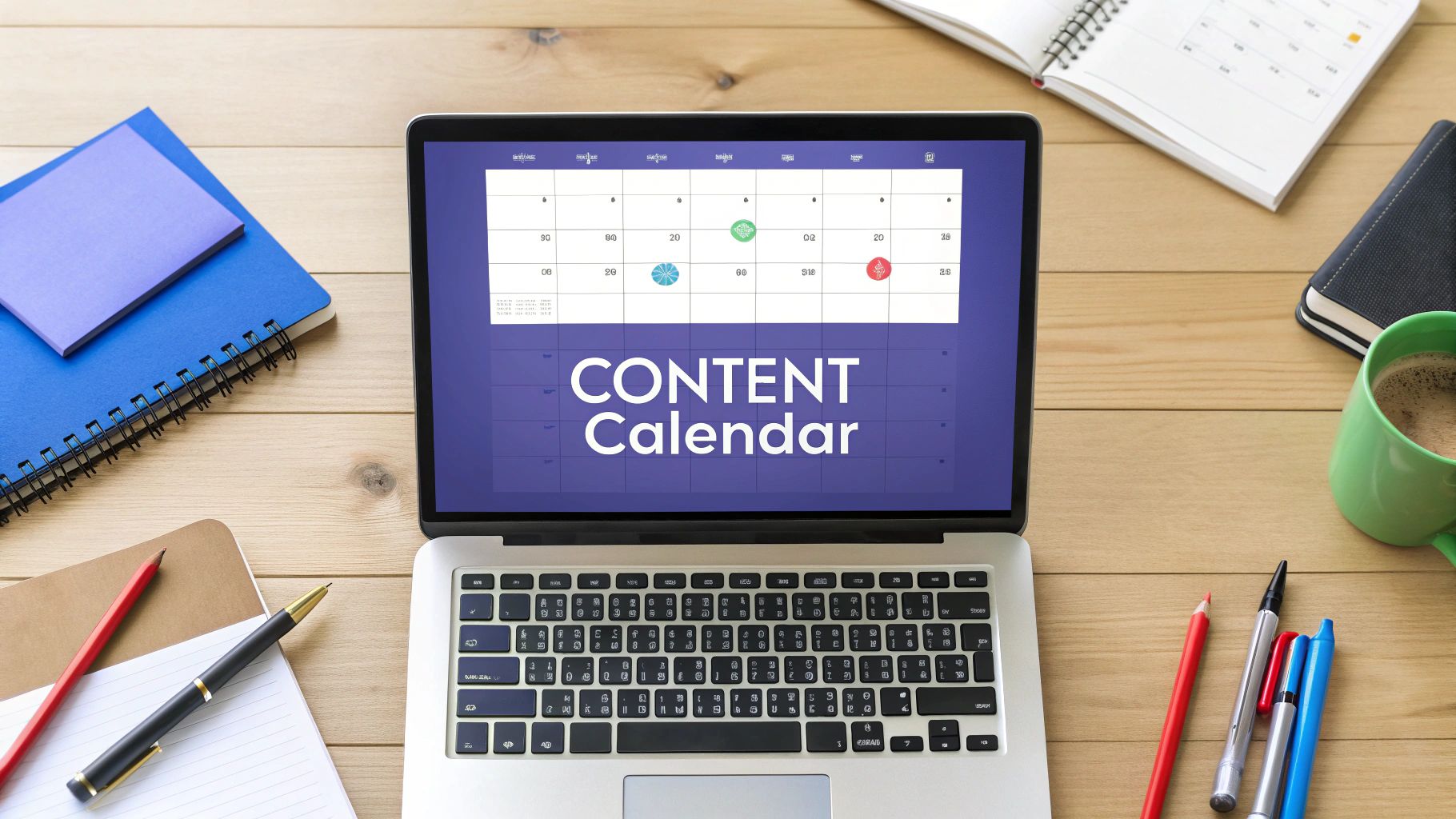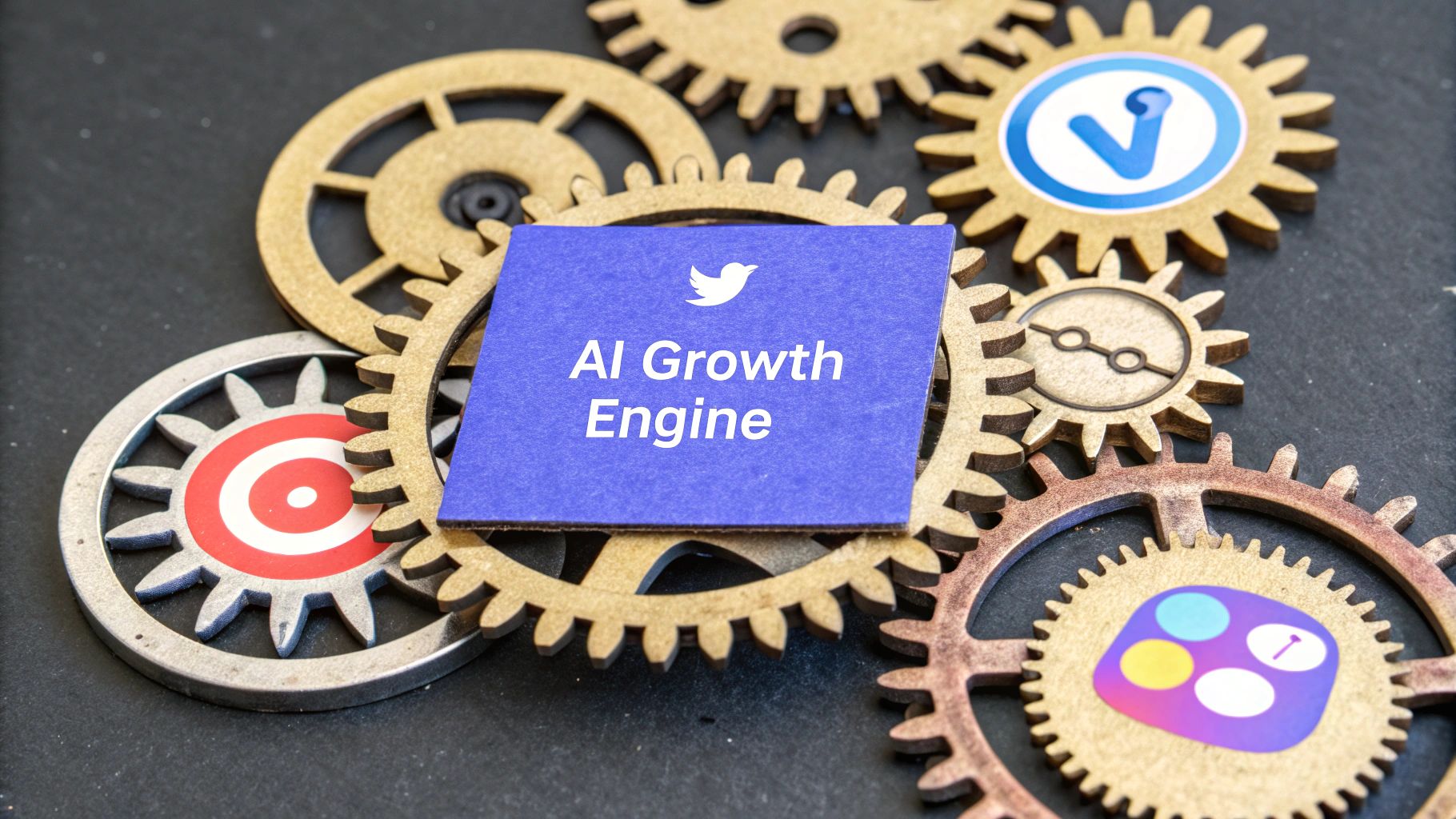A social media content calendar is, at its core, a detailed schedule of your upcoming social media posts, all neatly organized by date and time. But that’s a pretty dry definition.
It's much more useful to think of it as the essential blueprint for your brand's online story. It’s what takes you from posting on a whim to running a strategic, organized operation. It becomes your single source of truth, ensuring every piece of content works together.
Why a Content Calendar Is Your Strategic Blueprint
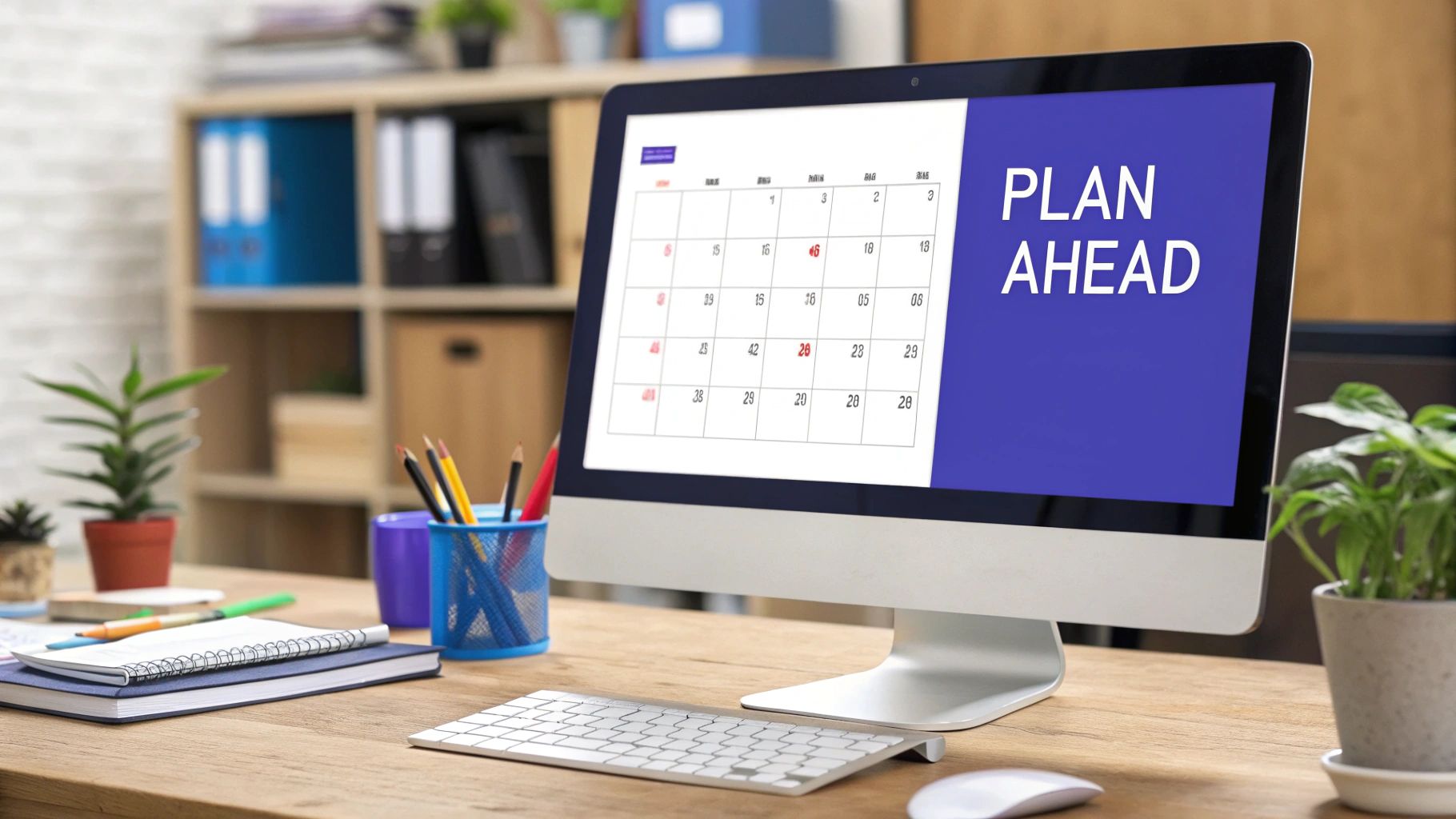
Ever tried to build a house without a blueprint? It would be pure chaos. You'd waste materials, nothing would line up, and the whole thing would probably fall over. A social media content calendar does the exact same job for your marketing, giving you the structure and foresight you need to build something that lasts. It shifts your entire strategy from being reactive to proactive.
Without a plan, managing social media feels like a daily fire drill. You're always scrambling, desperately trying to figure out what to post right now. This leads to inconsistent messaging, rushed (and often sloppy) content, and a ton of missed opportunities. It's a surefire way to burn out your creative energy and completely confuse your audience.
A calendar changes the entire game. It's not just about filling slots; it's about deliberately crafting a narrative for your brand. Suddenly, every post has a purpose and connects to a bigger goal, whether that’s boosting brand awareness, hyping a product launch, or just building a stronger community.
The Foundation of Brand Consistency
One of the biggest wins you get from a content calendar is rock-solid brand consistency. When you plan your content in advance, you can step back and see the big picture. This 30,000-foot view lets you make sure every single post aligns with your brand’s voice, visual style, and core message. Over time, that consistency is what builds trust and makes your brand instantly recognizable.
This methodical approach stops you from falling into the common trap of having a fragmented, all-over-the-place online personality. Instead of a jumble of disconnected posts, your audience gets a unified and professional brand experience. Getting started is simpler than it sounds, and using a ready-made https://postsyncer.com/blog/social-media-calendar-template can give you the perfect framework to build on.
From Stressful Scrambling to Strategic Planning
A well-organized calendar is a massive time-saver. It frees up an incredible amount of mental space. By "batching" your content—setting aside dedicated blocks of time to write copy, design graphics, and schedule everything out—you kill the daily pressure of having to create on the fly. This gives you the breathing room to focus on higher-level strategy, like digging into your analytics and actually engaging with your community.
A content calendar isn’t just a scheduling tool; it's a strategic asset that prevents costly mistakes, ensures every post has a purpose, and empowers your team to collaborate effectively.
Ultimately, to really unlock its power, you first need to understand how to create an effective social media content calendar. This structured system also makes team collaboration a breeze. When everyone can see the content pipeline, miscommunications drop, and approvals get streamlined. Your calendar becomes the command center for a stronger, more engaging brand.
Anatomy of a High-Performing Content Calendar
Let's look under the hood. A truly effective social media content calendar is so much more than a simple spreadsheet or a list of dates. It's the strategic command center for your entire social media operation. It’s what separates random acts of posting from posting with real purpose.
To build a calendar that actually drives results, you need to include the right pieces from day one. Some are foundational—the absolute non-negotiables that form the skeleton of your plan. Others are more advanced, adding the strategic muscle that helps you pull ahead of the competition.
Let’s break them both down.
The Foundational Elements
Every single social media calendar, no matter how simple or complex, needs a core set of information to function. Think of these as the basic building blocks that keep everything clear, organized, and on track. Without them, things get chaotic, fast.
This is the classic "who, what, where, when" of your social media activity. It’s the essential info anyone on your team needs to understand the plan at a glance.
- Publishing Date and Time: The exact day and hour each post is scheduled to go live.
- Social Media Platform: Clearly states which network the content is for (e.g., Instagram, LinkedIn, TikTok).
- Post Copy: The final text for the post, including any @mentions or #hashtags.
- Visuals: A direct link to the image, video, or graphic, usually stored in a shared drive like Google Drive or Dropbox.
- Links: The URL you’re driving traffic to, often shortened with a tool like Bitly for tracking.
A well-structured calendar built on these fundamentals creates a powerful flywheel effect.
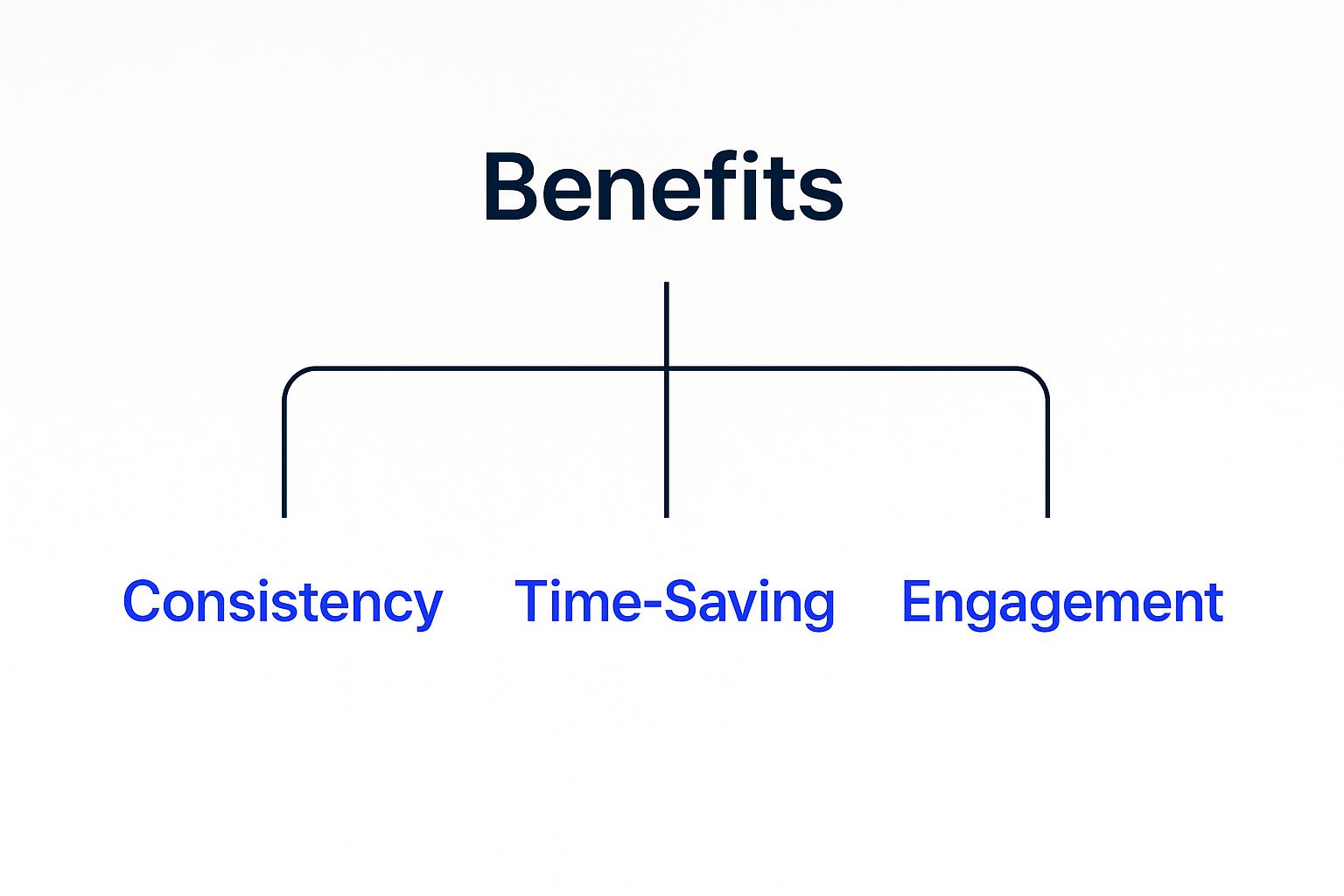
As the image shows, consistency saves you time, which frees you up to create better content, which in turn boosts engagement. It’s a beautiful cycle.
Advanced Components for Strategic Impact
Once you’ve mastered the basics, it’s time to level up. This is where you transform your calendar from a simple schedule into a strategic weapon. Advanced components add deeper context, tie your social media efforts back to real business goals, and allow for much smarter performance tracking. This is what separates a good calendar from a great one.
These details add the "why" and "how" to your strategy, turning your calendar into a roadmap for genuine growth.
A great social media content calendar doesn't just tell you what to post; it explains why each post matters and how it connects to your bigger marketing goals.
This is where you stop thinking like a coordinator and start thinking like a strategist.
- Content Pillars: These are the core themes or topics your brand owns (e.g., "Behind the Scenes," "Educational Tips," "Community Spotlights"). Assigning a pillar to each post ensures you’re creating a balanced and intentional content mix.
- Campaign Tags: Simple labels that group posts tied to a specific initiative, like a product launch or seasonal sale (e.g., #SummerSale2024). This makes it ridiculously easy to measure the results of a specific campaign.
- Post Format: Get specific about the media type—is it a Reel, a Carousel, a Story, or a static image? This helps you create a diverse feed that plays to each platform's strengths.
- Call-to-Action (CTA): What, exactly, do you want people to do? ("Shop Now," "Learn More," "Comment Below"). A clear CTA is often the difference between a post that gets likes and a post that gets leads.
- Approval Status: This is essential for team collaboration. A simple column to track where a post is in the pipeline ("Draft," "In Review," "Approved," "Scheduled") prevents costly mistakes and miscommunication.
To make this crystal clear, here’s a breakdown of what you absolutely need versus what you can add to take your planning to the next level.
Essential vs. Advanced Calendar Components
This table separates the must-have fields for any functional calendar from the advanced ones that will give your strategy a serious edge.
| Component | Description | Type |
|---|---|---|
| Publishing Date & Time | The exact moment your post goes live. | Essential |
| Platform | Which social network the post is for (e.g., Instagram, TikTok). | Essential |
| Post Copy | The final text, including hashtags and mentions. | Essential |
| Visuals/Assets | A direct link to the final image, video, or graphic. | Essential |
| Links | The URL you want to share, preferably with tracking. | Essential |
| Content Pillars | The strategic theme or topic the post falls under. | Advanced |
| Campaign Tags | Groups posts related to a specific marketing initiative. | Advanced |
| Post Format | The type of media used (e.g., Reel, Carousel, Story). | Advanced |
| Call-to-Action (CTA) | The specific action you want the audience to take. | Advanced |
| Approval Status | Tracks the post's progress in the workflow (e.g., Draft, Approved). | Advanced |
Starting with the essentials is a must, but integrating the advanced components is how you build a calendar that not only keeps you organized but actively helps you grow your brand.
How to Build Your First Content Calendar Step-by-Step
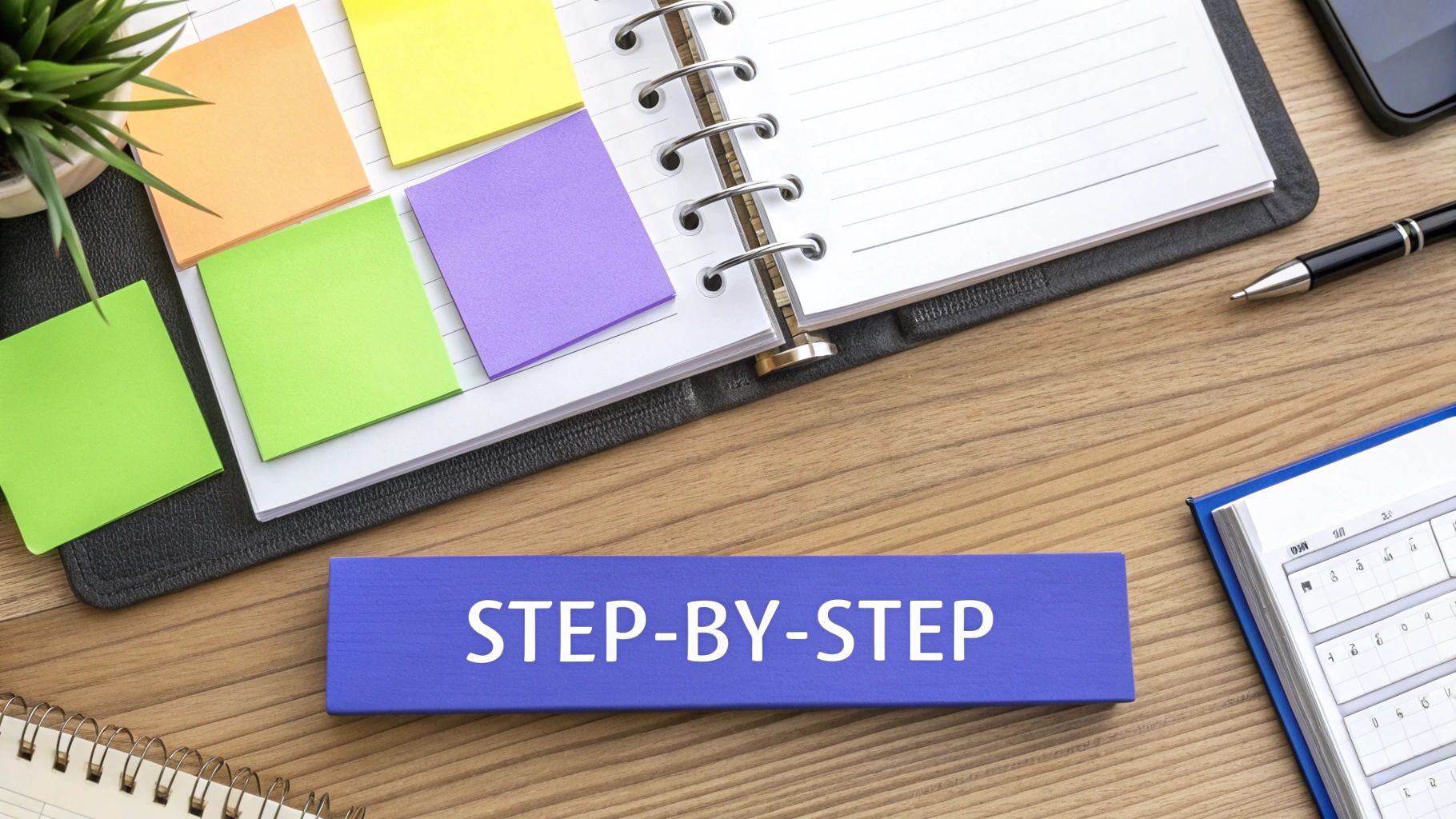
Alright, let's move from theory to action. This is where a social media content calendar really starts to shine. Building one isn't about locking yourself into a rigid, unbreakable plan; it's about designing a flexible system that brings a little order to all that creative chaos. I'll walk you through the process, taking you from a blank slate to a powerful tool that actually works for your brand.
Think of it like building a custom command center for all your content. The end goal is a single source of truth that simplifies your day-to-day, gets your team on the same page, and makes sure every single post has a purpose.
1. Conduct a Thorough Social Media Audit
Before you can map out where you're headed, you need a crystal-clear picture of where you are right now. A social media audit is that crucial first step. It's about taking an honest, clear-eyed look at your current performance to find the patterns, successes, and duds that will inform your entire strategy.
Whatever you do, don't skip this part. The insights you dig up here are the very foundation your content calendar will be built on.
Start by digging into these key questions for each of your social media profiles:
- What's Working? Pinpoint your top-performing posts. What topics, formats (think Reels vs. carousels), and tones are really clicking with your audience?
- What's Not Working? Which posts just fell flat? Look for content that got crickets in the comments or completely missed the mark.
- Who Is Your Audience? Dive into your audience demographics. Are you actually reaching the people you want to? When are they most likely to be scrolling?
- What Are Your Competitors Doing? Take a look at the content strategies of 2-3 of your main competitors. Note how often they post, what their core topics are, and what seems to be working for them.
2. Define Your Core Content Pillars
With your audit done, it's time to establish your content pillars. These are the 3-5 core themes or topics your brand will consistently own. Think of them as the main sections in a magazine; they give your content structure and make sure you're always delivering a balanced mix of value to your audience.
These pillars are what keep you from drifting off-brand and make brainstorming a whole lot less painful.
For example, a local fitness studio's content pillars might look something like this:
- Workout Tutorials: Short, actionable video guides.
- Nutrition Tips: Quick recipes and healthy eating advice.
- Member Spotlights: Celebrating the success stories from within your community.
- Behind the Scenes: Showcasing the gym's unique culture and trainers.
Your content pillars are the strategic guardrails for your creativity. They ensure every post you create is relevant, valuable, and directly contributes to your brand's overarching story.
3. Choose the Right Calendar Format
Here’s the thing: the "best" tool for your social media content calendar is simply the one your team will actually use. There's no need to overcomplicate things, especially when you're just getting your feet wet. The format should fit your team's size, workflow, and budget—not the other way around.
1. Spreadsheets (Google Sheets or Excel): The perfect starting point. They’re free, incredibly customizable, and easy to share. This is the go-to for solo creators or small teams. 2. Project Management Tools (Trello, Asana, Notion): Fantastic for growing teams who need better collaboration features. You can use cards or tasks to track a piece of content from a rough idea all the way to publication. 3. Dedicated Social Media Platforms (like PostSyncer): The most powerful route. These tools combine your calendar with scheduling, analytics, and approval workflows all in one spot, creating a genuinely seamless process.
The best advice? Start simple. Only upgrade when your current system is causing more friction than it solves. If you're looking for some guidance, this detailed walkthrough on how to create a social media calendar is a great place to start.
4. Establish a Sustainable Workflow
Finally, it's time to map out your content creation workflow. This is the assembly line that takes a spark of an idea and turns it into a polished, published post. Having a clear workflow stops bottlenecks before they start, cuts down on errors, and makes sure everyone on the team knows exactly what they're responsible for.
For a deeper dive into this, you can explore some great tips on how to create an editorial calendar that will align perfectly with your social media goals.
A standard workflow might look like this:
- Brainstorming: Generate ideas and drop them into an "idea bank" within your calendar.
- Creation: Assign a creator to whip up the copy and visuals.
- Review: Send the draft over to a manager or client for feedback.
- Approval: Once it gets the green light, the post is marked as ready to go.
- Scheduling: The post is plugged into your social media scheduling tool.
- Publishing: The content goes live!
By following these steps, you can turn a process that often feels chaotic into a predictable and effective system, setting your brand up for consistent success.
Using Your Calendar for Strategic Campaign Planning
https://www.youtube.com/embed/iONDebHX9qk
A great social media content calendar is so much more than a to-do list for your posts. Think of it as your strategic command center—the high-level view that turns random social media activity into a cohesive, goal-driven marketing engine. This is where you graduate from just scheduling content to actually managing campaigns.
When you zoom out from the day-to-day grid to a quarterly or even yearly perspective, your calendar becomes the single source of truth for your entire marketing plan. It's the perfect place to map out major product launches, seasonal promos, and big-picture brand campaigns, making sure every single post is working in harmony with your business goals.
Mapping Out Themes and Tentpole Events
The first move in any strategic plan is to lock down your "tentpole" events. These are the big, unmovable moments on your calendar—think major holidays, industry trade shows, or your company's annual conference. By plugging these in first, you create anchors that the rest of your content can revolve around.
With those anchors in place, you can start layering in quarterly themes. A wellness brand, for instance, might dedicate Q1 to "New Beginnings," Q2 to "Outdoor Fitness," Q3 to "Mindful Nutrition," and Q4 to "Rest and Recovery." This approach ensures your content tells a consistent story over time, saving your feed from feeling disjointed and random.
Your content calendar isn't just about scheduling posts; it's about orchestrating a narrative. By planning around key dates and themes, you create a rhythm that keeps your audience engaged and your brand story clear.
Tying your content to important dates is also a smart way to join bigger conversations. Major holidays and awareness days, like World AIDS Day on December 1 and International Volunteer Day on December 5, give brands a natural way to connect with global themes and boost engagement. As this guide on building a killer social media content calendar at adicator.com explains, this tactic makes your posts feel more relevant and timely.
Achieving a Strategic Content Balance
One of the quickest ways to lose followers is to constantly hit them with sales pitches. A well-planned content calendar helps you sidestep this trap by making it easy to visualize and balance different types of posts. The goal is to make sure you're providing value way more often than you're asking for a sale.
A balanced content mix is essential for keeping your audience interested and preventing follower fatigue. You want to create a well-rounded experience that educates, entertains, and connects with your community.
- Promotional Content (The Sell): This is your direct stuff—product announcements, special offers, and clear calls-to-action. Keep this to a smaller, though still impactful, portion of your total content.
- Educational Content (The Teach): Think tutorials, how-to guides, industry insights, and quick tips. This kind of content positions your brand as a helpful expert and builds a mountain of trust.
- Community-Focused Content (The Connect): This is all about engagement. We're talking user-generated content (UGC), behind-the-scenes peeks, polls, and Q&As that make your audience feel like part of the family.
A great pro tip is to color-code these categories in your calendar. If you glance at your month and see a sea of promotional green, you know it's time to sprinkle in more educational blue or community-focused yellow. It's an instant visual check.
Aligning the Entire Team for Cohesive Execution
Finally, your content calendar is the ultimate collaboration tool, getting everyone on the same page. When your social media efforts are perfectly in sync with what the sales, PR, and product teams are doing, the results are amplified tenfold.
Imagine the sales team being ready for a flood of leads from a social campaign, or the customer support team being prepped for questions about a new feature you're about to highlight. That level of coordination is flat-out impossible without a central, accessible plan. It turns the calendar from a simple schedule into a vital operational tool that drives cohesive action across the whole company. This kind of planning also paves the way for smarter execution, and you can learn how to automate social media posts to bring these strategies to life without the manual grind.
How to Keep Your Content Calendar Relevant and Effective

Putting together your social media content calendar is a huge first step, but the work doesn't stop there. A truly effective calendar isn't a rigid plan you set in stone and walk away from. Think of it as a living, breathing document that needs regular attention to keep delivering results.
The real magic happens when you build a simple, repeatable system for maintaining and optimizing it. This is what turns your calendar from a basic schedule into a powerful strategic tool that can adapt on the fly. You need a plan that’s solid enough to provide direction but flexible enough to jump on a sudden trend or pivot when a certain type of content just isn't landing.
How do you do that? By listening to your audience, digging into your analytics, and being ready to adjust your strategy based on real-world data, not just what you think will work.
Harness the Power of Social Listening
One of the best ways to keep your content feeling fresh and timely is social listening. This is just a fancy way of saying you’re actively paying attention to conversations happening on your social channels—monitoring brand mentions, industry keywords, comments, and DMs. It’s like having a direct line into your audience’s mind, giving you priceless, real-time feedback.
With users spending over 14 billion hours daily on social media, the sheer volume of conversation is staggering. This creates a goldmine of data you can tap into to understand what your audience truly cares about. For a deeper dive into these user habits, check out the latest social media statistics on talkwalker.com.
By truly listening, you can:
- Identify Pain Points: What are people always asking? What problems are they trying to solve? Every single question is a potential content idea.
- Spot Emerging Trends: Catch that viral audio, a new meme format, or a trending topic before everyone else does.
- Gather Unfiltered Feedback: See what your customers really think about your brand, products, or services.
- Find User-Generated Content (UGC): Discover authentic posts from happy customers that you can ask to reshare.
Establish a Rhythm of Performance Reviews
Your analytics are your roadmap. Without them, you’re just throwing content at the wall and hoping something sticks. A regular, structured review process helps you make informed decisions, so you can double down on what’s working and ditch what’s falling flat.
A content calendar without performance reviews is like driving without a GPS. You're moving, but you have no idea if you're heading in the right direction. Regular check-ins ensure you're always on the fastest route to your goals.
This doesn't have to be some massive, time-consuming project. The key is to break it down into a simple, manageable routine.
Your Framework for Agile Calendar Management
A consistent review cycle is what keeps you sharp and responsive. Here’s a simple but incredibly effective framework you can start using right away:
1. The Weekly Check-In (15-30 minutes)
This is your quick pulse check. The goal here is to spot immediate opportunities and fix any glaring problems before they get bigger.
- Review Comments and DMs: See any recurring questions or hot topics popping up?
- Scan for Trends: Anything new blow up that you could riff on?
- Check Post Performance: Did any posts totally crush it or completely bomb this week?
- Confirm Upcoming Posts: Give next week’s content a final look-over.
2. The Monthly Performance Review (1-2 hours)
This is where you zoom out and get more strategic. You’ll analyze the bigger patterns to inform your content plan for the next month.
- Identify Top and Bottom Performers: Look at key metrics like engagement rate, reach, and clicks for the entire month.
- Analyze by Content Pillar and Format: Are certain themes resonating more than others? Are Reels still outperforming carousels?
- Review Audience Growth and Demographics: Are you attracting the right kind of followers?
- Update Your Plan: Use what you’ve learned to brainstorm and refine your social media content calendar for the next 30 days.
By making these simple reviews a habit, your calendar will transform from a static schedule into a smart, responsive engine that’s constantly improving your social media game.
Your Top Content Calendar Questions, Answered
Even with the best-laid plans, questions are bound to pop up. When you're in the trenches managing a social media calendar, certain challenges just come with the territory. This section is your go-to reference for tackling the most common hurdles that stump social media managers and creators.
We'll cut right to the chase with clear, practical answers. Think of this as the expert advice you need to fine-tune your planning, pick the right gear for your team, and never stare at a blank calendar again. Let's turn that schedule into a serious strategic advantage.
How Far in Advance Should I Plan My Social Media Content?
Finding that perfect planning window is a constant dance between being prepared and staying flexible. For most brands, planning your content one month in advance is the sweet spot. This gives your team enough breathing room to brainstorm ideas, create quality assets, and get everything approved without that last-minute scramble.
But a one-month plan isn't set in stone. The smartest approach is a rolling system. While this month's content is going live, you should already be building out the calendar for next month. It keeps the content engine humming.
Here's the critical part: always leave a few open slots in your weekly schedule. You need that wiggle room to jump on real-time trends, react to breaking news, or share a great piece of user-generated content that just popped up. For the big stuff—like a Black Friday push or a major product launch—you'll want to map out those key "tentpole" moments two to three months ahead to make sure everyone is on the same page.
What Are the Best Tools for Managing a Content Calendar?
Honestly, the "best" tool is whichever one actually works for your team’s size, workflow, and budget. There's no magic bullet here, and sometimes, starting simple is the smartest move you can make.
- Spreadsheets (Google Sheets, Excel): For solo creators and small teams, this is the perfect, no-cost starting line. A well-organized spreadsheet is surprisingly powerful, totally customizable, and a breeze to share.
- Project Management Tools (Asana, Trello, Notion): When your team starts to grow, these tools are a lifesaver for collaboration. You can turn content ideas into cards or tasks and visually track them from "Idea" to "Drafting" to "Approved." That kind of visibility is a game-changer.
- Dedicated Social Media Platforms: For teams that need the whole package—advanced scheduling, deep analytics, and formal approval steps—a dedicated platform is the gold standard. It brings every part of the process under one roof.
The key takeaway? Start with the simplest tool that gets the job done. Only upgrade when your current system starts to cause more problems than it solves.
How Do I Fill My Calendar When I Run Out of Ideas?
Creator's block is real, and it happens to everyone. The moment you feel stuck, your first move should be to go straight back to your content pillars. They're your North Star, ensuring that whatever you come up with still feels on-brand and hits the right notes.
When the well feels dry, try these tried-and-true tactics to get the ideas flowing again:
- Go Mining for Customer Questions: Your DMs, emails, and support tickets are a goldmine. Every single question a customer asks is a content idea that solves a real-world problem for your audience.
- Repurpose What You Already Have: You don't always need to reinvent the wheel. That long blog post? It can become a carousel. That webinar? Chop it up into a dozen short video clips. A customer case study can easily be turned into a powerful quote graphic.
- Shine a Spotlight on User-Generated Content (UGC): Get your audience involved! Create a unique hashtag and encourage people to share their experiences. Featuring UGC is a fantastic way to build a community and fill your calendar with authentic, trustworthy content.
- Pull Back the Curtain: People love seeing what goes on behind the scenes. Show off your team, your creative process, or just a day in the life at your company. It humanizes your brand and forges a much stronger connection.
Here's a pro tip: Keep a running "idea bank"—a simple document or a dedicated column in your calendar. Whenever a random idea pops into your head, jot it down. That way, you’ll have a whole stash of inspiration waiting for you on those less-creative days.
What Is the Ideal Posting Frequency on Social Media?
Let's get one thing straight: there is no single magic number. Consistency and quality will always trump sheer quantity. The right posting cadence is all about the platform you're on and how your audience behaves. It is far, far better to publish three incredible posts a week than it is to dump ten mediocre ones and then disappear for a while.
As a general starting point, here’s a common rhythm for major platforms:
- Instagram Grid: 3-5 times per week
- Instagram Stories: 7-15 times per week
- LinkedIn / Facebook: 1-2 times per day (or 3-5 times per week if posts are high-value)
- TikTok: 5-7 times per week
The golden rule is to find a schedule you can actually stick to. Dive into your analytics to see when your audience is online and most active, then adjust based on that data. Don't be afraid to test different frequencies to find the rhythm that works for your brand and your team.
Ready to transform your social media strategy with a powerful, intuitive calendar? PostSyncer provides an AI-driven platform that centralizes your content creation, scheduling, and analytics. From our drag-and-drop calendar to collaborative approval tools, we empower your team to work smarter, not harder. Start your free 7-day trial and see how easy it is to build a high-performing social media presence.
